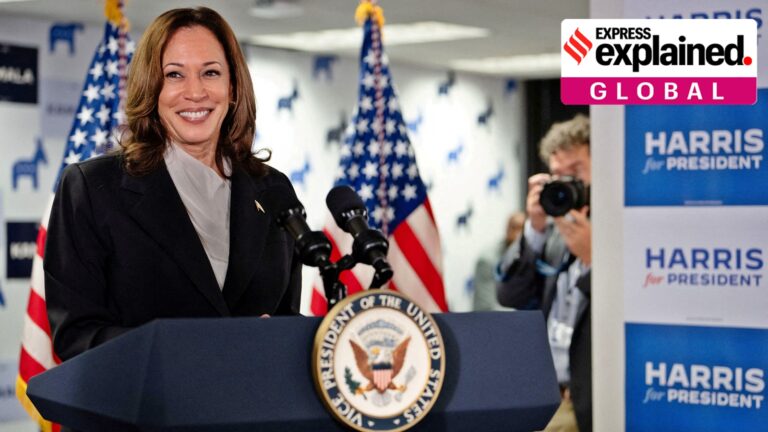US President Joe Biden announced on Sunday (July 21) his intention to withdraw from the 2024 presidential race and endorsed Vice President Kamala Harris as the party’s new nominee. “My first decision as the party’s nominee in 2020 was to select Kamala Harris as my vice president, and it was the best decision I ever made,” Biden said.
She’s not an immediate candidate, but her political stance, age, and the diverse demographic she represents are key factors. Gives a specific advantageIt also helps that no significant challenger has emerged from her party.
Harris is likely to become the party’s official candidate in the November election, which would be historic, similar to when she became the first female, Black and South Asian vice president of the United States in 2020.
My first trip with my Indian-Jamaican parents
Kamala Harris was born in Oakland, California on October 20, 1964. Her mother, Shyamala Gopalan, was a prominent breast cancer researcher from Chennai, India, and her father, Donald Harris, was an economist from Jamaica.

This multicultural heritage has influenced Harris’ worldview and her career, as she has reflected on her journey: “My mother used to look at me and say, ‘Kamala, you may be the first to do a lot of things, but make sure you’re not the last.'”
She attended Howard University and then the University of California School of Law, where she was admitted to the California Bar and later joined the Alameda County District Attorney’s Office, specializing in the prosecution of child sexual assault cases.
From District Attorney to U.S. Senator
A key moment in Harris’ political career was when she was elected district attorney of San Francisco in 2003. In 2010, she was elected attorney general of California, where she promoted progressive policies such as consumer protection and criminal justice reform.
“My vision of a progressive prosecutor was one who exercised his or her office with fairness, perspective and experience, who was clear-sighted about the need to hold serious criminals accountable, and who understood that the best way to create safer communities is to prevent crime,” she later wrote in her memoir. Her national profile grew as she took on leading roles on issues such as health care and immigration.
But Harris has also faced criticism, particularly from progressive groups. Reuters Her approach to school truancy law, which involved prosecuting parents of chronically absent children, was seen by many as punitive and disproportionately impacting low-income and minority families, according to the report.
Harris was elected to the California Senate in 2016, where she gained recognition for her questioning in committee hearings and advocacy on key issues like climate change, health care and criminal justice reform. Her legislative work laid the foundation for her rise to the national stage.
Vice Presidential Inauguration: A Historic Moment
In 2020, Kamala Harris made history by being appointed Vice President. This was a milestone in American politics and a sign of the diversity of American political leadership. As President of the Senate, Harris served in a record number of runoff elections for Vice President.
As one example, she secured passage of the landmark Inflation Reduction Act, which aims to address America’s inflation, climate change, and health care costs problems through large-scale investments.
One of the Biden administration’s biggest weaknesses is its inability to address the crisis at the southern border, where record numbers of migrants have crossed into the U.S. illegally over the past few years. Many have criticized Harris for Biden giving her the responsibility to address the root causes of the increase in migrants from some countries to the U.S. Democrats have criticized her for telling migrants “don’t come.”
Potential nominations and their impact
Her candidacy, potentially making her the first woman of South Asian and Black descent to run for the top job, highlights the emergence of broader political representation, reflecting America’s diverse, multiracial demographic.
Articles from 2019 As The Conversation pointed out:“The percentage of white people in the U.S. population has declined from just under 90% in 1950 to 60% in 2018, and is likely to fall below 50% within the next 25 years.”
According to 2020 U.S. Census Bureau data, the multiracial population in the United States makes up approximately 10.2% of the total population. This number grew from 9 million in 2010 to 33.8 million in 2020, an increase of 276%. The South Asian American community is also one of the fastest growing groups in the United States. The “Asian Indian” population category in particular grew 56% from 2.8 million in 2010 to 4.4 million in 2020.
Harris’ candidacy could shape how Democrats approach issues such as immigration, health care and women’s rights, and her progressive platform would position her as a direct counterweight to the politics of former President Donald Trump.
But her victory over the Republican candidate is far from assured: She is not known as a particularly charismatic leader, and she does not have the luxury of time, especially compared to the popularity Trump enjoys among his supporters.
Recent polls, conducted before the assassination attempt on Trump and before Biden’s withdrawal, show the race close. The Washington Post A July 21 poll showed Trump with a “slight” lead over Harris, after Biden’s weak performance in the first televised debate between Trump and Biden on June 27 prompted calls for a replacement.
The writer is an intern at The Indian Express.

